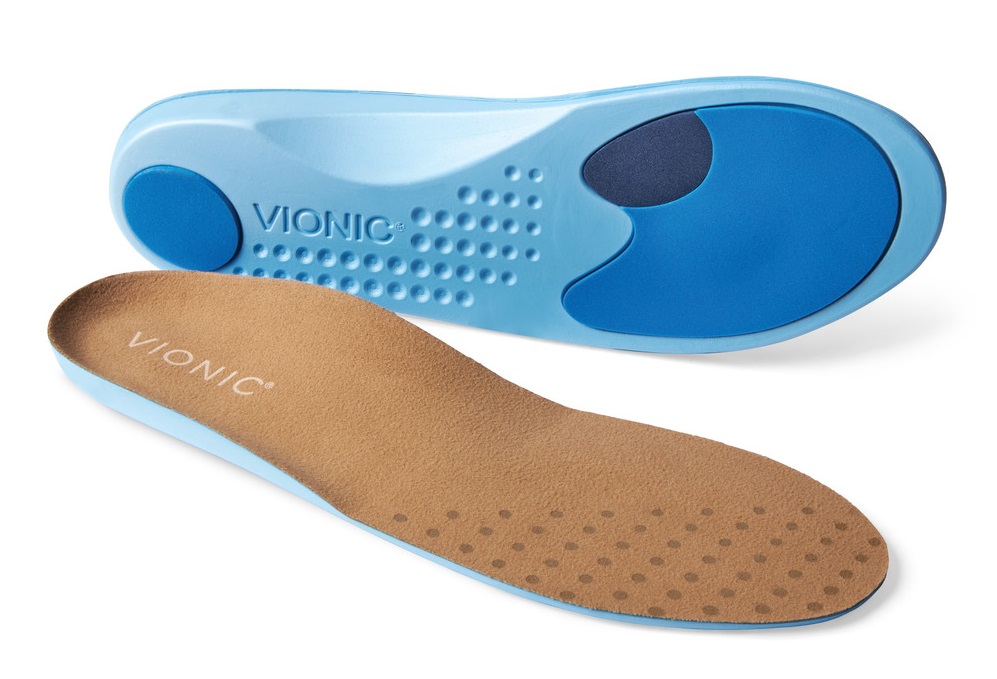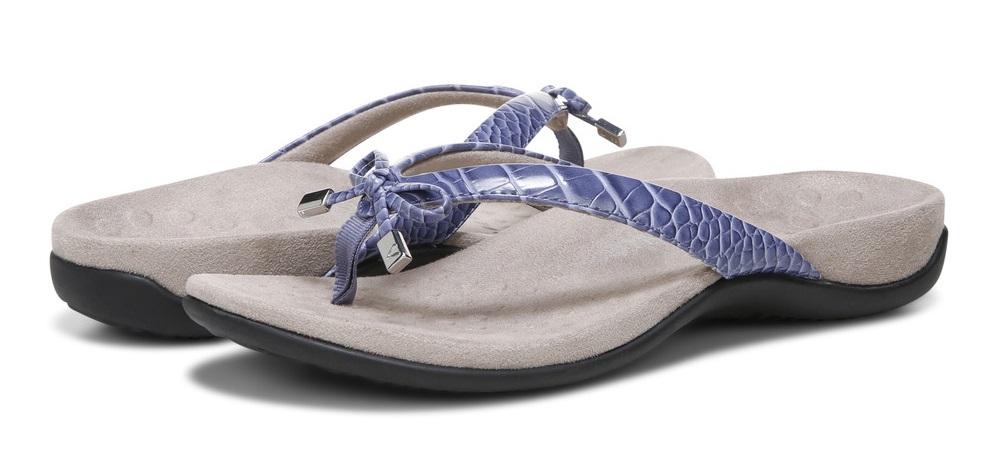
Pain in your toes, heels, ankles, and arches can really put a damper on your quality of life, especially when it’s chronic. Getting to the root of the issue is the first step in fixing the problem. So, what causes sore feet?
There are many potential culprits behind tenderness, throbbing, and inflammation. Find a rundown of the various causes of sore feet below along with available Vionic orthotics to alleviate these symptoms.
21 Sore Feet Causes
Here at Vionic, we believe comfortable, pain-free feet are the key to happiness. Think about it: If you can’t walk without feeling discomfort or opt out of activities for fear it’ll make things worse, you might miss out on life’s greatest joys.
Some of the most common sore feet causes include:
- Bunions
- Ingrown toenails
- Bone spurs
- Plantar fasciitis
- Plantar warts
- Heel spur
- Morton’s neuroma
- Peripheral neuropathy
- Tarsal tunnel syndrome
- Achilles tendinitis
- Rheumatoid arthritis
- Extensor tendonitis
- Posterior tibial tendonitis
- Psoriatic arthritis
- Flat feet
- Hammertoe
- Claw toe
- Turf toe
- Stress fractures
- Improper footwear
Here’s what you should know about these potential causes and what your options are for addressing further foot problems.
Bunions
Bunions are bony bumps at the base of the big toe.¹ What causes bunions? They typically form when bones in the front of the foot shift out of place, pulling the big toe toward the other toes and forcing the joints to stick outward.
You’ll usually be able to see the protrusion and might notice redness around the area. Tight-fitting shoes are not only a potential cause of bunions, but they can also make existing ones worse. Foot deformities and certain medical conditions can result in bunions as well. If you’re wondering can bunions be reversed, check out our blog for more information as well as some of the best sandals for bunions available on our site.
Ingrown Toenails
An ingrown toenail happens when the side or upper corner of a toenail grows into the surrounding skin.² While it occurs most often with the big toe, you can get ingrown toenails on any toe. At best, they can cause redness and discomfort, and at worst, they can be incredibly painful and lead to infection.
Bone Spurs
A bone spur occurs when excess bone forms at the end or edge of a bone in the foot, creating a hard, smooth bump.³ Also called osteophytes, these bony projections are sometimes associated with osteoarthritis and can go unnoticed for years before a person starts experiencing foot pain or discomfort.

Plantar Fasciitis
Among the most common causes of heel pain, plantar fasciitis occurs when the plantar fascia (the band of tissue connecting the toes to the heel) becomes inflamed. It can result in soreness, ongoing discomfort, and often a sharp pain. Runners, overweight individuals, and those who wear shoes that lack support have the highest risk of developing plantar fasciitis.
Plantar Warts
A plantar wart is a small growth on the foot, usually under weight-bearing areas like the heel and ball of the foot.⁴ This condition is caused by HPV (human papillomavirus). When the virus enters the body through a cut or scrape on the bottom of the foot, the weighted pressure creates warts.
Heel Spurs
Occurring in half of people with plantar fasciitis, heel spurs are calcium deposits that create a bone-like protrusion underneath the heel bone.⁵ The condition can be painless, though the inflammation can also lead to chronic foot pain, soreness, and discomfort.
Morton’s Neuroma
Often causing a sharp or stinging pain in the ball of the foot, Morton’s neuroma is a thickened nerve tissue between the toes.⁵ It can feel like you have a small rock in your shoe or like your sock is on wrong. Morton’s neuroma usually requires medical attention in addition to switching out your shoes for better footwear.
Peripheral Neuropathy
Peripheral neuropathy is a type of nerve damage that can cause tingling, numbness, weakness, a burning sensation, or sharp pain in the feet.⁶ It can also affect the hands and other parts of the body.
Tarsal Tunnel Syndrome
Your tarsal tunnel is the narrow space inside your ankle next to your bones. Tarsal tunnel syndrome (TTS) happens when nerves get pinched or compressed while passing through this tunnel.⁷ The condition can cause soreness, numbness, and severe pain.
Achilles Tendonitis
Achilles tendinitis occurs when the tissue connecting to the calf muscle to the lower leg is injured or inflamed as a result of overuse.⁸ It’s relatively common among athletes and recreational exercisers and is associate with leg pain and chronically sore feet.
Extensor Tendonitis
Your extensor tendons are found in the muscles used to flex your feet and raise your toes. Extensor tendonitis happens when these ligaments become inflamed, which leads to swelling and pain.
Posterior Tibial Tendonitis
Posterior tibial tendonitis occurs when the tendons in the inner ankles become inflamed.⁹ The condition often follows an ankle sprain, but not always. People with posterior tibial tendonitis may experience pain in their inner foot and potentially have trouble walking with a natural gait.
Rheumatoid Arthritis
Rheumatoid arthritis (RA) can affect every part of the body, including the feet. If you have the condition, you might feel stiff, tender, or achy, especially after walking, running, or standing for long periods.
Psoriatic Arthritis
Psoriatic arthritis is an inflammatory illness affecting the joints.¹⁰ It can cause swelling, tenderness, and chronic pain in the toes and ankles and might lead to mobility issues.
Flat Feet
Flat feet (or fallen arches) mean the soles of your feet are flat and touch the floor entirely in a standing position.¹¹ Some people experience fallen arches after an injury or with age, while others never develop arches during childhood.
Hammertoe
Hammertoe is a type of foot deformity resulting from imbalanced muscles and ligaments that are supposed to hold the toe straight.¹² It can happen following an injury or develop from wearing improper shoes.
Claw Toe
Claw toe happens when the outermost joints in a toe bend inward like a claw and are unable to straighten back out.¹³ The painful, potentially debilitating condition can be hereditary or a result of a muscle imbalance—but ill-fitting footwear can also be a culprit.
Turf Toe
Turf toe occurs when the big toe bends too far, ultimately tearing ligaments in the joint.¹⁴ As the name suggests, this painful foot ailment is common among football players and track athletes who push off from their toes before a sprint.
Stress Fracture
A stress fracture is a small crack in a bone, typically resulting in overuse.¹⁵ This type of foot injury often shows up in the weight-bearing bones in the feet and ankles. Stress fractures can be immensely painful and are generally accompanied by swelling and ongoing tenderness.
Wearing the Wrong Shoe Size
Wearing the right shoe size doesn’t just keep you comfortable—it can also prevent various foot-related ailments and painful conditions. If you haven’t measured your feet in years (or ever), we highly recommend doing so. You might be surprised how much better your puppies feel when you rock the proper size and width.

Unsupportive Footwear
Beyond getting the proper size, wearing supportive footwear is crucial in preventing aching feet and soreness. Look for a pair with sufficient arch support and heel stability, like the stylish shoes we carry at Vionic—extra points if they have the APMA Seal of Acceptance from the American Podiatric Medical Association.
The Most Comfortable Shoes and Orthotics for Pain-Free Feet
There is a wide range of potential sore feet causes. And while there’s no one-size-fits-all solution, comfortable footwear can make a huge difference in remedying the issue. Vionic aims to tackle some of the most common foot concerns, including questions like what is foot pronation? By offering insight and helpful tips regarding overpronation vs underpronation or with how to correct overpronation, you can begin giving your feet the proper treatment they need.
From recovery sandals to performance shoes, every pair of podiatrist-designed shoes from Vionic features built-in orthotics, completely hidden within the soles. Once you get a taste of our crave-worthy arch support and contoured footbeds, you’ll wonder how you ever got by without them.
We also carry orthotics, which you can use in place of the insoles of virtually any pair of shoes. Vionic shoe inserts boast the same orthotic technology as our biomechanically engineered footwear, so you can count on all-day comfort and a pep in your step. Order a set today!
External sources:
- “Bunions”. Mayo Clinic. https://www.mayoclinic.org/diseases-conditions/bunions/symptoms-causes/syc-20354799
- “Hammertoe and mallet toe”. Mayo Clinic. https://www.mayoclinic.org/diseases-conditions/hammertoe-and-mallet-toe/symptoms-causes/syc-20350839
- “Bone spurs”. Mayo Clinic. https://www.mayoclinic.org/diseases-conditions/bone-spurs/symptoms-causes/syc-20370212
- “Plantar warts”. Mayo Clinic. https://www.mayoclinic.org/diseases-conditions/plantar-warts/symptoms-causes/syc-20352691
- “Heel spurs: Do they always cause pain?”. Mayo Clinic. https://www.mayoclinic.org/diseases-conditions/bone-spurs/expert-answers/heel-spurs/faq-20057821
- “Peripheral neuropathy”. Mayo Clinic. https://www.mayoclinic.org/diseases-conditions/peripheral-neuropathy/symptoms-causes/syc-20352061
- “Tarsal Tunnel Syndrome”. Johns Hopkins Medicine. https://www.hopkinsmedicine.org/health/conditions-and-diseases/tarsal-tunnel-syndrome
- “Achilles tendinitis”. Mayo Clinic. https://www.mayoclinic.org/diseases-conditions/achilles-tendinitis/symptoms-causes/syc-20369020
- Bubra, Preet Singh et al. “Posterior tibial tendon dysfunction: an overlooked cause of foot deformity.” Journal of family medicine and primary care vol. 4,1 (2015): 26-9. doi:10.4103/2249-4863.152245 https://www.ncbi.nlm.nih.gov/pmc/articles/PMC4367001/
- Mease et al. “About Psoriatic Arthritis”. National Psoriasis Foundation. Published 2013. https://www.psoriasis.org/about-psoriatic-arthritis/
- “Flatfeet”. Mayo Clinic. https://www.mayoclinic.org/diseases-conditions/flatfeet/symptoms-causes/syc-20372604
- “Claw Toes”. Cleveland Clinic. https://my.clevelandclinic.org/health/diseases/16875-claw-toes
- “Turf Toe”. Cleveland Clinic. https://my.clevelandclinic.org/health/diseases/17590-turf-toe
- “Stress fractures”. Mayo Clinic. https://www.mayoclinic.org/diseases-conditions/stress-fractures/symptoms-causes/syc-20354057


Leave a Reply